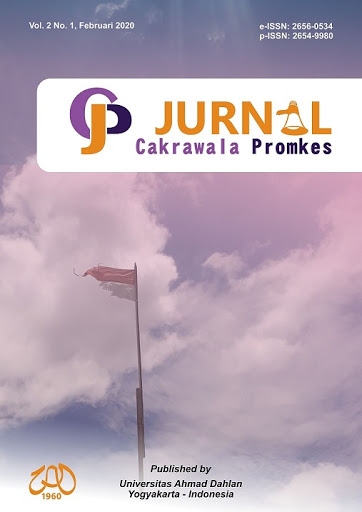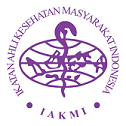Social and Epidemiological Diagnosis in Biru Village, Yogyakarta, using Community Diagnosis Approach
DOI:
https://doi.org/10.12928/promkes.v4i2.6465Keywords:
Community diagnosis, Family health, Hypertension, Diabetes, Upper respiratory tract infectionAbstract
Backround: Health in the community is formed from the closest and smallest environment, namely the family. Supported by the surrounding environment such as residence, school, workplace, and friends.
Objective: This study will analyze the health problems that occur, especially in 31 families in Dusun Biru, Yogyakarta, Indonesia. After being analyzed, suggestions will be given to seek solutions to health problems that occur.
Methods: The method used in this study is quantitative with a scoring technique. Previously, interviews would be conducted using a community diagnosis approach.
Results: Data showed that 1 person was diagnosed with ARI (infectious disease) and 26 others had non-communicable diseases such as asthma (2), diabetes mellitus (9), heart disease (1), hypertension (12), and stroke (2).
Conclusion: The highest health problems are hypertension and diabetes mellitus. Therefore, family support is needed to change a healthier lifestyle
References
Anggraini FDP, Tiara R. Penentuan Prioritas Masalah Kesehatan terkait Covid-19 dan Intervensinya dengan Pendekatan Problem Solving Cycle. J Pengabdi Kpd Masy Indones. 2022;2(1):38–47.
Syakurah RA, Moudy J. DIAGNOSIS KOMUNITAS DENGAN PENDEKATAN PROCEED- PRECEDE PADA MAHASISWA KEPANITERAAN KLINIK. J Heal Educ. 2022;10:1–19.
Utami DO, Sulistyawati S. Community Diagnosis dan Peningkatan Pengetahuan Penyakit Hipertensi pada Masyarakat RT. 02 Desa Dalam, Kecamatan Alas, Sumbawa. Abdimasku J Pengabdi Masy. 2021;4(3):320.
Patel MB, Maheen M, Shaikh FM, Chandrasekhar A. Community diagnosis by conducting family health survey in the field practice area of a medical college. Int J Community Med Public Heal. 2019;6(12):5190.
Manandhar P, Manandhar N, Chandyo RK, Joshi SK. Community Diagnosis on Health Seeking Behavior and Social Problems in Bhaktapur and Kavrepalanchok Districts of central Nepal. J Coll Med Sci. 2017;13(3):335–9.
Indarjo S, Siwiendrayanti A, Pawenang ET. The Community Diagnosis of Filariasis Endemic Villages in Pekalongan City. J Kesehat Masy. 2016;12(1):100–10.
Musfirah, Setyani DA. Community Diagnosis of Environmental Health Problems in Residents in Way Dadi Village, Bandar Lampung City. 2022;6(3):548–56.
Alberdi-Erice MJ, Martinez H, Rayón-Valpuesta E. A participatory community diagnosis of a rural community from the perspective of its women, leading to proposals for action. Int J Environ Res Public Health. 2021;18(18).
Musianto LS. Perbedaan Pendekatan Kuantitatif Dengan Pendekatan Kualitatif Dalam Metode Penelitian. J Manaj dan Wirausaha. 2012;4(2):123–36.
Mulyadi M. Penelitian Kuantitatif Dan Kualitatif Serta Pemikiran Dasar Menggabungkannya [Quantitative and Qualitative Research and Basic Rationale to Combine Them]. J StudKomun dan Media. 2019;15(1):128.
Dzalila L, Ananda A, Zuhri S. Pengaruh Pembelajaran Daring Pada Masa Pandemi Covid-19 Terhadap Tingkat Pemahaman Belajar Mahasiswa. J Signal. 2020;8(2):203.
Green WL. Health Promotion Planning an Educational & Environmental Approach. 2nd ed. Mayfield Publishing Company; 1991.
Riswanto A. Kemiskinan: faktor penyebab dan analisis pemecah masalah poverty: causes and troubleshooting analysis. J Sos Hum. 2016;7(1):59–72.
Lestari L, Zulkarnain Z, Sijid SA. Diabetes Melitus: Review etiologi, patofisiologi, gejala, penyebab, cara pemeriksaan, cara pengobatan dan cara pencegahan. Pros Semin Nas Biol. 2021;7(1):237–41.
Al Mansour MA. The Prevalence and Risk Factors of Type 2 Diabetes Mellitus (DMT2) in a Semi-Urban Saudi Population. Int J Environ Res Public Health. 2020;17(7):1–9.
Downloads
Published
Issue
Section
License
Copyright (c) 2022 Rochana Ruliyandari, Brilly Annisa Asdiany

This work is licensed under a Creative Commons Attribution-ShareAlike 4.0 International License.
Authors who publish with JCP: Jurnal Cakrawala Promkes agree to the following terms:
- Authors retain copyright and grant the journal the right of first publication with the work simultaneously licensed under a Creative Commons Attribution License (CC BY-SA 4.0) that allows others to share the work with an acknowledgement of the work's authorship and initial publication in this journal.
- Authors are able to enter into separate, additional contractual arrangements for the non-exclusive distribution of the journal's published version of the work (e.g., post it to an institutional repository or publish it in a book), with an acknowledgement of its initial publication in this journal.
- Authors are permitted and encouraged to post their work online (e.g., in institutional repositories or on their website) prior to and during the submission process, as it can lead to productive exchanges, as well as earlier and greater citation of published work.

This work is licensed under a Creative Commons Attribution-ShareAlike 4.0 International License












